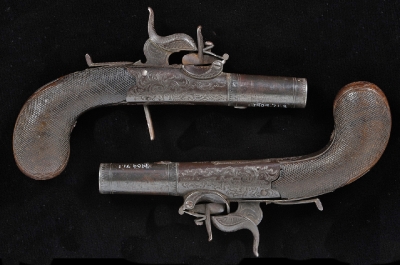Top-hat pistols (1909.71.1-2)
These smoothbore pistol have a turn-off barrel which means that the barrel unscrew from the chamber for loading. This allowed for a tighter-fitting bullet which reduced the loss of gas pressure, resulting in a more powerful and accurate shot. The concept was introduced with the ‘Queen Anne’ pistols made in the early 1700s and named after the British monarch at the time, but these examples were made about a century later by Clough and Sons of Bath.
At first it was thought that these had been older flintlock pistols converted to the new percussion system, as many guns were. This assumption was made because the striking steel (frizzen) appears to still be in place. However they are in fact a distinctive type of weapon dating to the early days of the percussion system c. 1825–35 known as ‘top-hat’ pistols due to the shape of the percussion caps they used. The part resembling the steel is actually a spring-loaded upright retainer, designed to hold the caps in place.
Within a short period top-hat pistols became obsolete as a new and definitive form of percussion cap was developed. However, larger top-hat style caps were still used by some percussion muskets, such as the Pattern 1853 Enfield (P53), which was partly designed by Pitt Rivers himself.





